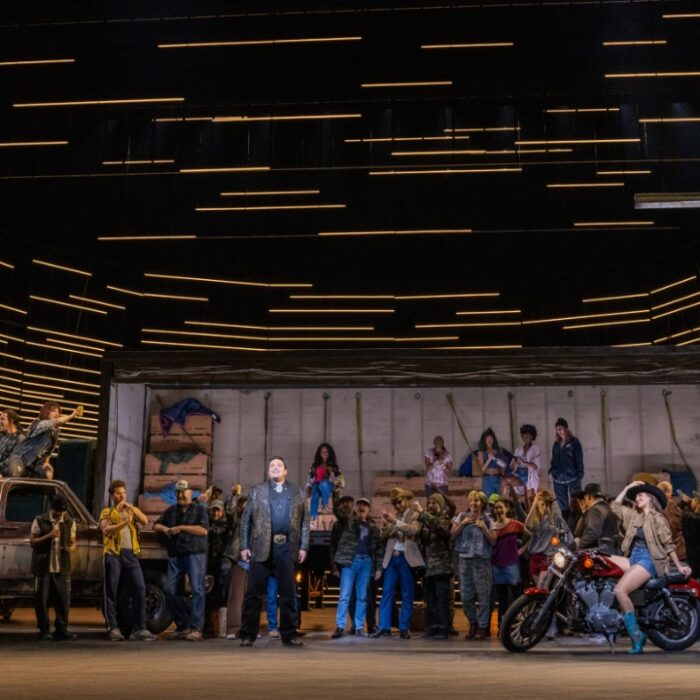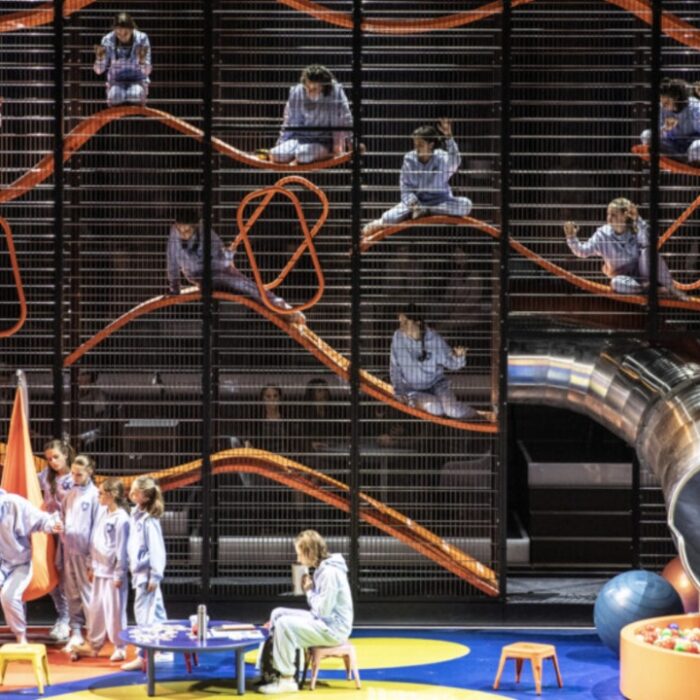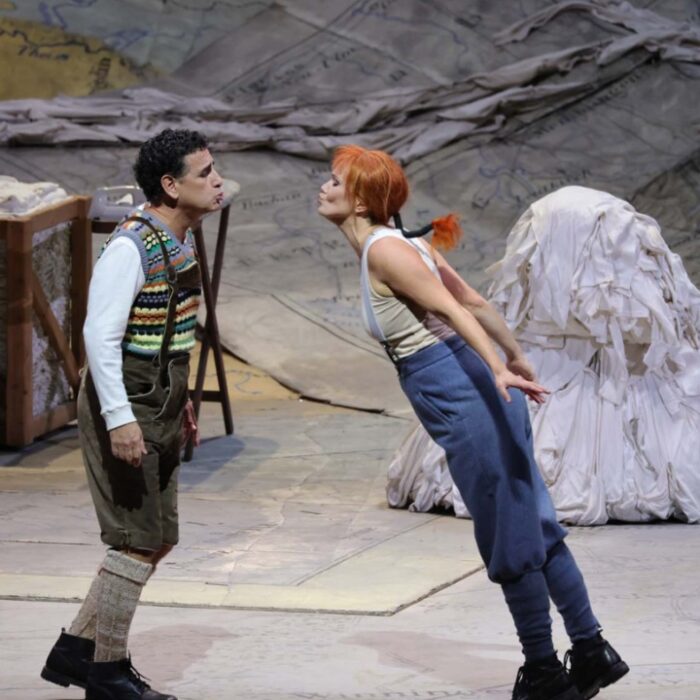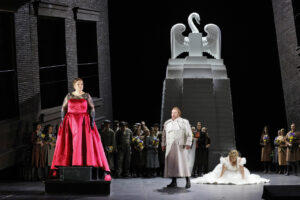
San Francisco Opera 2023 Review: Lohengrin
By Lois SilversteinRichard Wagner fell in love with the story of Lohengrin. How could he not? A handsome knight, with a golden disposition of purity, nobility and generosity. The son of Parsifal. The leader of the Grail. Destined to rescue, save and uplift all who needed rescuing and salvation. With soaring and beauteous romantic melodies, rich choral support, dazzling duets between glorious him and a golden-voiced soprano, Wagner brought him into a war-torn country to defend what he considered right and good– to make peace.
The poet-dreamer Wagner created “Lohengrin,” out of bel canto roots, in an Italianate score filled with lustrous melodies. With it he set the downbeat for his artistic work from this opera and this hero as an artist, lover, leader, and perhaps the man he himself yearned to be. Here again, is the story of how perfection deals with what is not.
San Francisco Opera opened its first production of “Lohengrin” in 11 years with director David Alden’s production, and associate director Peter Relton, where such fairy tales and legends became modern day political realism.
The stage set, designed by Paul Steinberg and production designer Tal Rosner, was a combination of stark topsy-turvy buildings and rubble. A once-upon-a-time Brabant, Antwerp becomes a war-torn European city. Rather than romantic swans, there are blazing red, white and black banners with swans curved into fascist icons; rather than poetic dreams, we have guns and fists. The presence of the lovely swan in Wagner’s story and score appear as a flutter of flashing lights across the set rather than the magic animal itself. For magic and beauty, “swanstikas” didn’t cut it. Nor did the swan monument in Act two, positioned brazenly on stage.
The touchstone of truth in the performance was the successful bringing together of all the forces Wagner amassed to tell the story of the Swan Knight: 71 piece orchestra with a full complement of winds and brass onstage and off, 15 principals each with a demanding role, 79 choristers, and a story which, in a hard-edged age like ours, is barely acceptable except when brought down to political earth, as the San Francisco Opera does in Alden’s vision, a political view of hatred, murder and revenge.
Close to Radiance
The singers fared well overall. They were rich with stamina and fire. Simon O’Neill came closest to the radiance Wagner sought in his hero. His upper register often gleamed and with little strain. Although not full-bodied but with shots of gold, he sang with point and reach, ever steady, ever committed. His “Mein lieber Schwan” in Act one was sung with his back to the audience. He was plaintive and moving, as one might imagine.
But by Act three, the second farewell had not evolved despite all that Lohengrin had undergone. He still remained regretful and fused with loss. In “In Fernem Land,” O’Neill sacrificed a full palette of colors to his ardent sound. While he didn’t vary or explore it much, this choice of piercing beauty largely made up for that. Certainly, his solid presence anchored him in the present, where otherworldly aspirations remained fantasy. When he came right into the audience before Act three, for instance, all otherworldly suggestions dissolved. Here was groom, husband, ordinary man, and radiance largely a shadow.
Elsa, sung by soprano Julie Adams, former Merola Opera singer in her San Francisco debut, brought rich beauty and vocal fullness to her role. She portrayed both the polite and graceful woman of legend. She was a modern day female who stood up to her challenge. As a legend, she succeeded in conveying the drama the character required – her elation over the embodiment of her dream lover, her joy over being defended from false accusation, her confusions over Ortrud’s disbelief in Lohengrin, her insistence on asking the forbidden question. In this she remained sympathetic, singing with ardor and confidence, filling the opera house with appealing legato and round tones that resonated. She asserted her desire to get what she wanted.
It did take its toll, however, as she realized she would lose Lohengrin as a result. From her sinking to the ground multiple times, crawling on occasion, even standing on the bed in Act three, from where she skewered her new husband, she began to assess the “black and white” model of her tactics. The Disney-descent of the wedding dress and her being dressed onstage, removing her veil and then pinning it back on. She became a woman who abjured magic and its appeal. Likewise the picnic bedspread plus champagne the director affixed her to earth, and the gleam of her own love and transcendence faded. Even when she and her brother reunited, the numinous moment did not catch fire.
Rich Villains
Ortrud, also a San Francisco opera debut performance by Romanian mezzo soprano Judit Kutasi sang with power and apt malicious intent. The audience loved how she ranted, raved and vowed vengeance. Despite their chuckling as if she were an Amazon Prime heroine, she continued with conviction and beauty, overcoming the satirical allusion. She performed not only as a wicked witch but as a virulent demonic woman, more than willing and able to seduce and wreak havoc on her nemeses who she bent to her will, her voice menacing and robust. Why did I marry you? Friedrich asks in Act two, but we have no doubt how come. When under her spell, who has a choice? She had her mind set and her voice kept it going, no question. She orchestrated her wicked ways with artful wiles galore, and she provided a stirring and stark contrast to Elsa. Just as Wagner wished.
Kutasi showed her wrath and wish for revenge when she seduces Friedrich; at the end of the Act when she verbally seduces Elsa, and at the finale, when she has the last word. Would Wagner want that? Perhaps not, but he was master enough to allow this character to take charge of the weaponry of evil and might not have objected. David Alden capitalized on this for the production.
Brian Mulligan sang Friedrich, Count of Telramund. His lovely baritone at first easily wooed us away from suspecting any evil and revenge he might cause at first. Beautiful round tones established his status as a trustworthy court member and as such believable. As the performance wore on, so did some of his sound, gradually seeming less vibrant and perhaps tired. So did his portrayal, even though he kept defending himself, in different ways and in different scenes. When he confronted Ortrud, for example in Act two, we thought he was going to give up. But when she managed to coax him into revenge, he rebounded.
Heinrich, sung by bass-baritone, Kristinn Sigmundsson sang his first note with gusto, but then lapsed into a somewhat tired and sad low-energy singing, his power fading. It was as if he were outlived, as if his rule no longer counted. The Herald, sung by Thomas Lehman, did an admirable job joining the story parts together as well as singing with suavity. He was Wagner’s narrator, with a wounded and patched up leg. One curious detail – when all the major action occurred centerstage, he was off downstage left reading a newspaper. Alden deliberately included another modern anachronism but only served to emphasize the decision to blur specific time and place. He flattened the power and feeling. Alden aimed for a present that wasn’t quite here or there. This effected the costumes as well, Gideon Davey and Simon Bennison‘s revival of Adam Silverman‘s original design of the lighting, which wandered too many times, even disappearing from Friedrich as he crept through the battling soldiers.
The Choruses, conducted by chorus director John Keene, performed with ample sound, complementing their narrative role. Their diction remained only intermittently clear, as they performed this necessary story-telling function. Sometimes they were not completely coordinated, as in the use of chairs they carried back and forth, producing moments of randomness and vague full-bodied statement. So too, introduction of lectern and other furniture, and the use of dancers, while graceful, ornamented what wasn’t essential to propel the drama.
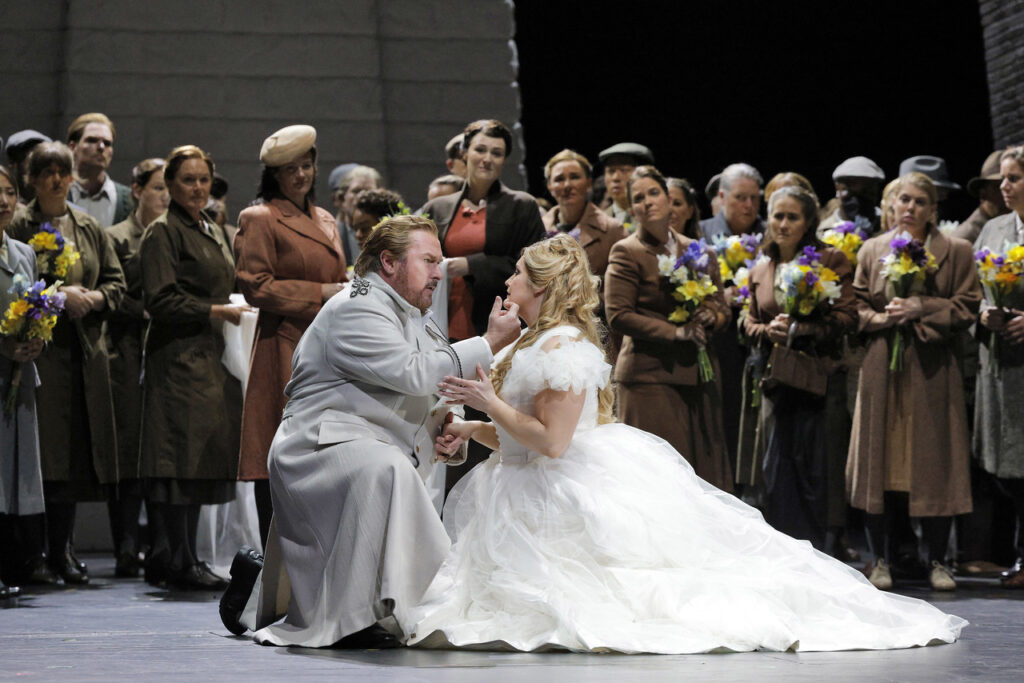
(Credit: Cory Weaver)
In Control
The brisk tempos of conductor Eun Sun Kim kept her in charge of the large orchestra the whole way, much like she did in Verdi’s “Il Trovatore.” While conducting the 71-piece orchestra in the pit and the 25-piece banda on stage, she remained on their toes, including the brass on and off-stage. She never flagged, nor did they. The opening Prelude set the downbeat of a realistic, down-to-earth performance. Eun Sun Kim concentrated the score on this world, perhaps a Berlin or a Dresden of 1945, rather than the ethereal atmosphere of myth. Right away, one might expect rubble women in a no-nonsense world rather than dream-maidens or heroes. No doubt from the music on which planet we were set.
Fortunately for the musicians and for Lohengrin himself and occasionally with Elsa and Ortrud, there was plenty of room to inject spots of the mystery that ignites the score. With slower tempi and fewer blazing climaxes, some of this could be felt. The details of the score – the otherworldly music, its melodic beauties, the human intimacies are ground down in favor of the all-too-familiar anguishes of our time. No question these familiar pains bring home some of the challenges of being an audience member for Wagner today and easier to endure. Even the four hours and 24 minutes of the performance kept the audience engaged, until the end. One could feel, however, Kim’s determination to take this story just where she wanted and that accented the main production point.
“Lohengrin” in San Francisco has more performances, including a live stream, where the production will no doubt tighten some of the looser moments but in no way alter its perspective. Terror told the story here and while its relevance sharpened the imperatives of our worldly drama, Wagner’s score remains rich with psychology and mystery.
